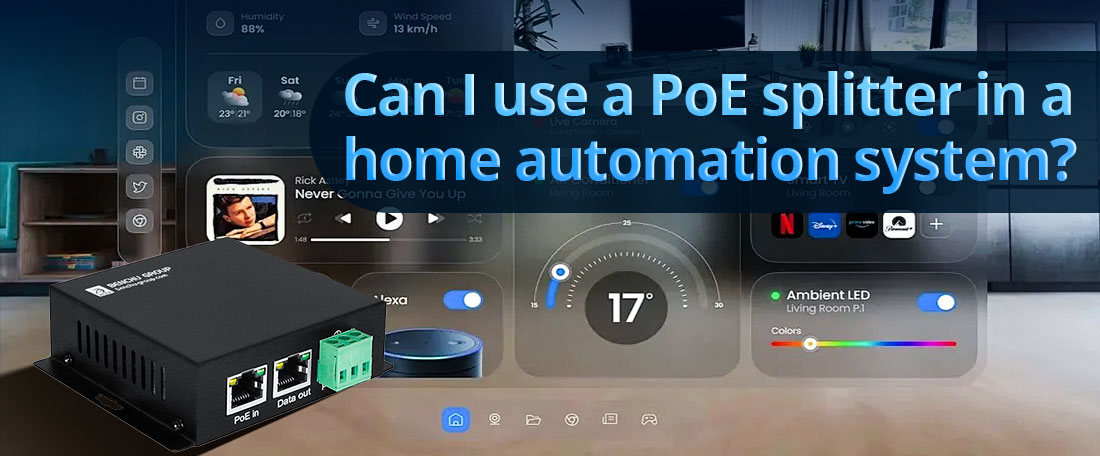
نعم ، يمكن أن يكون فاصل Poe حلاً فعالًا للغاية لنظام التشغيل الآلي للمنزل ، خاصة عند دمج الأجهزة الذكية التي تتطلب اتصالًا بالطاقة والشبكة ولكن لا تدعم POE أصليًا. يتيح لك فاصل Poe تشغيل الأجهزة المنزلية الذكية باستخدام كبل Ethernet واحد ، وتقليل فوضى الكابلات وتبسيط التثبيت.
كيف يعمل فاصل Poe في نظام أتمتة المنزل
A بوي فاصل يأخذ كابل Ethernet الذي يحمل الطاقة والبيانات وتقسيمه إلى:
--- بيانات Ethernet-للاتصال بالشبكة مع الأجهزة المنزلية الذكية.
--- إخراج طاقة التيار المستمر-يحول قوة POE (عادةً 48 فولت) إلى جهد أقل مناسبًا للأجهزة المنزلية الذكية (5V ، 9V ، 12V ، أو 24V).
--- يتيح لك هذا الإعداد استخدام مفتاح POE أو حاقن POE لتركيز إدارة الطاقة مع الحفاظ على الأسلاك الحد الأدنى.
فوائد استخدام فاصل Poe في أتمتة المنزل
1. يلغي الحاجة إلى محولات الطاقة المنفصلة
--- تتطلب العديد من أجهزة المنازل الذكية محولات الطاقة ويجب وضعها بالقرب من منافذ الطاقة.
--- يزيل فاصل Poe الحاجة إلى كابلات الطاقة الإضافية ، مما يسمح لتشغيل الأجهزة مباشرة من خلال كابل Ethernet.
2. يبسط التثبيت ويقلل من الفوضى
--- لا حاجة لتشغيل كابلات طاقة منفصلة للأجهزة الذكية.
--- يقلل من فوضى الكابل ويحسن جماليات ، خاصة بالنسبة للأجهزة المثبتة على السقف.
3. يوسع مرونة وضع الجهاز
--- يمكن وضع الأجهزة في أي مكان في متناول كابل Ethernet (يصل إلى 100 متر / 328 قدمًا).
--- لم يعد يقتصر على المناطق التي تحتوي على منافذ الطاقة القريبة.
4. إدارة الطاقة المركزية
--- جميع الأجهزة المنزلية الذكية مدعومة عبر أ تبديل بو أو يمكن إدارة الحاقن من موقع مركزي واحد.
--- يمكن استخدام UPS واحد (مصدر طاقة غير متقطع) لتوفير طاقة احتياطية لجميع الأجهزة المتصلة في حالة انقطاع التيار الكهربائي.
5. مثالي للمناطق التي يصعب الوصول إليها
--- يتم تثبيت العديد من الأجهزة المنزلية الذكية ، مثل كاميرات الأمان ، وأجهزة الاستشعار الذكية ، والأقفال الذكية ، في الأسقف أو المناطق أو المناطق الخارجية.
--- يتيح فاصل Poe توصيل الطاقة لهذه الأجهزة دون الحاجة إلى تثبيت منافذ طاقة جديدة.
6. حل فعال من حيث التكلفة
--- يتجنب الحاجة إلى عمل كهربائي إضافي ويقلل من تكاليف الكابلات.
--- البنية التحتية التي تدعم POE قابلة للتطوير ، مما يسهل توسيع نظام أتمتة المنزل في المستقبل.
7. يعزز الأمن والموثوقية
--- يضمن تشغيل أجهزة أمان المنازل الذكية مثل كاميرات IP وأجهزة استشعار الحركة والأقفال الذكية عبر POE التشغيل المستمر حتى أثناء تقلبات الطاقة (خاصة عند دمجها مع UPS).
--- يقلل من احتقان Wi-Fi عن طريق تمكين الاتصالات السلكية لنقل البيانات أكثر استقرارًا وآمنة.
الأجهزة المنزلية الذكية التي تستفيد من Poe Splitters
يمكن استخدام Poe Splitters مع أي جهاز منزلي ذكي يتطلب اتصال الطاقة والإيثرنت ولكنه لا يدعم POE أصليًا ، مثل:
| نوع الجهاز | كيف يساعد فاصل بو |
| كاميرات الأمن الذكية | يوفر الطاقة والبيانات من خلال كابل Ethernet واحد للكاميرات غير بوي. |
| جرس الباب الذكي | Powers Smart Doorbells التي تستخدم Ethernet السلكية ولكنها تتطلب جهدًا أقل. |
| منظمات الحرارة الذكية | يسمح بالتنسيب في أي مكان في المنزل دون الاعتماد على خطوط الطاقة الحالية. |
| أقفال ذكية | يزيل الحاجة إلى تغييرات في البطارية المتكررة أو الأسلاك المعقدة. |
| أجهزة الاستشعار البيئية | تعمل درجة الحرارة والرطوبة وجودة الهواء وأجهزة استشعار الحركة دون الحاجة إلى مصادر طاقة منفصلة. |
| مراكز الأتمتة المنزلية | يركز على الطاقة لوحدات التحكم في المنزل الذكية والمراكز. |
| وحدات تحكم الضوء الذكي | يتيح التوضع عن بُعد لأنظمة الإضاءة الذكية مع الموثوقية السلكية. |
مثال: استخدام فاصل Poe لكاميرا أمان المنزل الذكية
سيناريو
تريد تثبيت كاميرا أمان ذكية غير بوي خارج منزلك ، ولكن لا يوجد منفذ للطاقة القريب.
الحل باستخدام فاصل بو
1. قم بتوصيل مفتاح Poe أو حاقن إلى جهاز التوجيه الخاص بك.
2. قم بتشغيل كابل Ethernet من مفتاح Poe إلى موقع الكاميرا.
3. قم بتوصيل فاصل Poe في موقع الكاميرا.
4. قم بتوصيل إخراج الطاقة من الخائن بإدخال DC للكاميرا.
5. قم بتوصيل إخراج Ethernet من الخائن بمنفذ Ethernet للكاميرا.
6. يتم الآن تشغيل الكاميرا وتوصيلها بالشبكة ، دون الحاجة إلى منفذ طاقة قريب.
اعتبارات رئيسية عند اختيار فاصل POE للأتمتة المنزلية
1. توافق الجهد
--- تتطلب الأجهزة الذكية المختلفة فولتية مختلفة (5V ، 9V ، 12V ، أو 24V).
--- تأكد من مطابقة فاصل POE الجهد المطلوب للجهاز.
2. متطلبات الطاقة
تحتاج بعض الأجهزة إلى قوة أكثر مما يوفره Poe القياسي.
معايير Poe Power:
--- بو (802.3AF): ما يصل إلى 15.4W لكل ميناء.
--- Poe+ (802.3at): ما يصل إلى 25.5W لكل ميناء.
--- POE ++ (802.3BT): ما يصل إلى 60W-100W لكل منفذ.
تحقق من استهلاك القوة الكهربائية للجهاز لضمان التوافق.
3. سرعة الإيثرنت
--- يدعم بعض Poe Splitters فقط 10/100 ميغابت في الثانية ، بينما يدعم آخرون Gigabit (1000 ميغابت في الثانية).
--- بالنسبة للأجهزة ذات النطاق العريض العالي (على سبيل المثال ، كاميرات الأمان ، مراكز الأتمتة) ، تأكد من دعم الخائن Gigabit Ethernet.
4. حدود المسافة
--- يمكن لـ POE نقل الطاقة والبيانات حتى 100 متر (328 قدمًا).
--- لمسافات أطول ، فكر في استخدام موسع بو.
خاتمة
نعم ، يعد Splitter Poe حلاً ممتازًا لأنظمة التشغيل الأتمتة المنزلية ، مما يتيح لك تشغيل الأجهزة الذكية غير بوي وتوصيلها باستخدام كبل Ethernet واحد. إنه يبسط التثبيت ، ويقلل من الفوضى ، ويزيد من مرونة الموضع ، ويعزز موثوقية النظام.
من خلال دمج تقنية POE في منزلك الذكي ، يمكنك إنشاء شبكة أتمتة أكثر كفاءة وفعالية من حيث التكلفة وقابلة للتطوير مع تقليل الاعتماد على منافذ الطاقة التقليدية.